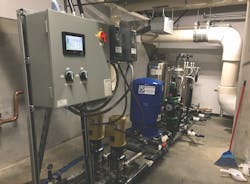About the author:
Benjamin Morrison is water resources engineering technologist for CleanFlo Water Technologies. Morrison can be reached at [email protected].
In the fall of 2018, the Ikea located in Richmond, BC, Canada, wanted to update its current rainwater harvesting technology. The original building in Richmond was built in 2012, and the rainwater harvesting system was installed to flush toilets and urinals only.
Rainwater harvesting, while an ancient practice, has been revolutionized by new technology, as well as increasing concerns about storm water management, water conservation and water scarcity. While the concept is simple in theory, integrating a rainwater collection system with a building can be complex and require multidisciplinary knowledge bases.
Notably, rainwater harvesting offers businesses a financial return on investment (ROI) through water savings. In Canada, most building owners are charged for water in three ways:
1. A flat fee is charged, depending on the size of the water service pipe entering the building;
2. A usage rate per cubic meter of water is used, ranging from $1 to $4 or higher; and
3. The sewer use is charged typically on 90% of water use and ranging from $1 to $4 per cu meter.
In addition, as storm water management is increasingly more regulated, rainwater harvesting provides an effective way to manage storm water. Alternatively, water scarcity is becoming more common as homes and buildings are being built outside of centrally treated water networks. Groundwater is harder to find, making wells increasingly uncertain options. Rainwater can provide a potable, reliable and sustainable primary source of water.
Overcoming Challenges
Ikea's water utility management company approached Cleanflo Water Technologies. A manufacturer of rainwater harvesting systems in Canada, Cleanflo Water Technologies provided Ikea a system that included new pumping, treatment and control components.
There were a few challenges to implementing this type of system. The original system had to be removed; the access to a mechanical room was restricted to a single door 30-in. wide; and city bypass needed to be upgraded to meet the updated plumbing codes.
In order to properly accomplish the removal of the original system, the city water temporarily was tied to the toilet and urinals, and the rainwater system was disconnected. Then, the old system was completely removed, and a new rainwater pumping and treatment skid was installed.
Next, due to access restriction, the pre-built skid system had to be disassembled and rebuilt in the mechanical room. Typically, the systems are sent as a pre-built skid and simply are anchored in place. The team re-designed the typical skid system so it easily could built in the shop, factory tested, then disassembled, shipped and reassembled.
Finally, in the event the system completely failed and the pumps did not operate, the toilet and urinals would have no water. The system required a manual connection directly to the city water. British Columbia plumbing code does not allow any cross connection between non-potable and potable water supplies involving rainwater; therefore, the company installed two sections of pipe that can be removed using unions at each end.
Only one section of pipe can be in place at a time. One section connects rainwater pumps to the building piping and the other section of pipe connects the city mains to the building pipes. Having one section of pipe in use at a time meets the plumbing code. At the same time, the design provided a quick and simple way for building maintenance to switch over to city water in a system failure event.
How Ikea's Rainwater Harvesting System Works
The system works effectively for Ikea's needs. Rooftop rainwater is captured, cleaned, and sanitized, then pressurized for toilet and urinal flushing. Municipal water is added to the system as a back-up if the rainwater cistern is empty.
First, rainwater is collected from the rooftop. Next, rainwater enters a 100,000-liter concrete cistern built into the building. The cistern should have an overflow to the storm system that should it be filled to capacity during a rain event.
Then, a processing skid located inside the building contains components for pumping, final filtration, sanitation and controls.
For conveyance to the processing system, water from the cistern is pumped to the processing skid via two vertical, multistage booster pumps. A low-level float switch in the cistern signals when make-up water is needed.
Before the water is sent to the toilets and urinal system, it passes through a three-step filtration process. The first is a mechanical filter that removes particulates down to 80 μ. This filter is self-cleaning and will automatically back flush as needed based on a timed cycle or differential pressure. The second and third stages are proprietary to the Cleanflo Treatment System for rainwater.
Sanitizing the water before it leaves the system ensures that it is safe for use in a public building. After water is filtered, it is sanitized by an ultraviolet system rated to handle 200 gal per minute (gpm)-four chambers each can handle 50 gpm-and then sent to the toilet and urinal system.
When there is a demand for non-potable water, a drop in the system pressure signals the main pressurization pump to begin. A vertical multistage booster pump next to the cistern in the mechanical room will provide 80 gpm at 75 psi, which should be sufficient to meet the demand. The pump incorporates a variable frequency drive that automatically adjusts speed during low and high volume demand, thus saving energy and reducing pump wear. If the system requires more than 80 gpm, then the second multistage booster pump in parallel installation will be signaled to start, providing up to 160 cpm.
If the system demands additional water from the cistern when the cistern is empty, a municipal water make-up valve in the mechanical room automatically opens, sending makeup water to the cistern. Water from the potable water line is added through an air gap opening to prevent any chance of cross contamination of non-potable water to the potable system. A float in the cistern regulates the amount of make-up added in each cycle.
The system is controlled and monitored via the Cleanflo Control System with custom programmed PLC and panel. The control system automatically manages all system functions, including the water treatment system and the addition of municipal water as needed, and is fully compatible with Building Automation Systems via Modbus or Bacnet. The system logs and reports the amount of water available in the cistern, how much water has been captured for reuse, and the amount of municipal water demanded by the system. Information and system alerts and alarms are presented via a color touch screen on the control panel and a network cable to the building automation system. The screens can be viewed and the system controlled remotely throughout the building via a web browser connected to the building's network. The control panel’s main power supply is from the building’s 208V/3PH/60HZ, 60 AMP service.
Water Savings
In Richmond, water and sewer charges are based on water use; therefore, for water, the store saves $1.24 per cu meter of water used and, for sewer, $1.11 per cu meter of water used. For every cubic meter of rainwater Ikea reuses, it saves $2.35. Since the system was up and running, from March 8, 2019, to April 16, 2019, the store has saved 401 cu meters or a total of $943.35. In other words, approximately 10.3 cu meters per day translates to $24.16 per day in savings. The peak day was April 5, 2019, when the store used 38 cu meters of rainwater for toilets and urinals with a single day water savings of $89.30.
Based on the average of $24.16 per day in water savings, this store would save approximately $8,807.45 per year in water savings. Based on the peak day of $89.30 per day in water savings, this store would save approximately $32,594.50 per year in water savings.
The company predicts that this store will save approximately $20,000 in water savings, or 8,510 cu meters per year. With a 5% increase to water and sewer costs per year in most jurisdictions, the second year may save approximately $21,000 in annual water savings. After 10 years, water and sewer could be as high $3.83 per cu meter, resulting in an annual saving of $32,580.
Like many commercial properties, Ikea Richmond has made a commitment to invest in a rainwater system by incorporating the infrastructure into the initial build. It now has moved forward with an updated technology incorporating many innovative approaches.


